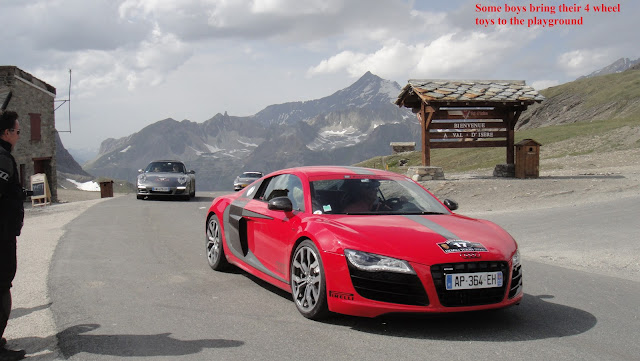We push on to two of the Cols made famous by the Tour de France - du Lautaret and du Galibier which stand at 2058 and 2642 metres respectively. We cannot imagine what this place is like during le Tour as even on this mid-week day the road is littered with lycra clad cyclists, assistance vehicles, sports cameramen and painted messages of support from previous Tours. In amongst this melee are the motorcyclists with grins from ear to ear. The Col du Galibier is especially tight. Despite the mix everybody seems happy with their lot and there are no signs of road rage. There is still snow up here but the day remains pleasantly warm. We take our photos and push on to Valloire for a lunch break then onto the Col du Telegraphe. Martin has warned us about the descent from this Col and he was not exaggerating - the road has recently been resurfaced and is covered with loose bluemetal. Good fun on a fully laden bike with very tight descending hairpin turns.
Our hunger for more corners has us diverting from our northward trip up the Col du Mont Cenis at 2084 metres. The approach is more open and flowing with cleaner view lines through the hairpin turns. The reward at the top is a view over the Lake du Mont Cenis and the border with Italy. We turn around and descend back to the Route des Grandes Alpes and continue our journey on to the final major climb of the day, the Col de L'Iseran at 2770 metres. This is the highest paved pass in the Alps. We have an exhilarating descent to the Ski Village of Val d'Isere which is to be home for the night. Ski Villages in summer are a bit like beach resorts during a wet winter - in a state of hibernation and uncomfortable when there is no mass of tourists to feed and house. We are tired after a long day so are happy with an early night.
The next day starts with a descent through mountain tunnels past waterfalls and the beautiful Lake du Chevril. We are now running along a rich valley of thick pastures and contented cows. As we ascend the Cormet de Roselend we cross paths with a herd of bell clanging cattle and a mobile dairy. We have never seen anything like this in Australia but in this isolated high country it is logical to bring the dairy to the cattle. There is a road tanker pumping direct from the mobile dairy truck. It all looks very efficient. This Col is not one of the hardest to climb but it is one of the most beautiful with a lake just over the crest on the north side and a descent through pine forests. We cross the smaller Col des Saises before stopping for lunch at the pretentious sounding village of Notre Dame de Bellecombe. A note here about lunchtime for the French. They treat lunch very seriously. It is not unusual to see a group of manual workers sit down to a large lunch with a carafe or two of wine before returning to work - but not before 2pm. Do not be surprised either to see 'closed for lunch' signs at many businesses. We pass on the vin and enjoy a perrier with our sumptuous salads before remounting on another warm afternoon.
The second part of the day takes us over the Col des Aravis with its little roadside chapel to St Anne, the protector of travelers, and through to La Clusaz. The last of the famous Tour de France climbs, the Col de la Colombiere, is the most crowded of them all. We see more motorcycles here than we have seen since leaving the Isle of Man, and the cyclists outnumber the motorcyclists. Lucky for us it is a week day. There are also spectators with their picnic lunches dotted across the hillsides which adds to a very carnival atmosphere. From here we start to catch our first glimpses of the snow capped Mont Blanc to the north-east. We have a fast descent from the Col before the country starts to flatten as the Route des Grandes Alpes makes its final march to the shore of Lake Geneva. We must part company however at Cluses to tackle one of the most famous passes, the Grand St Bernard Pass, and our crossing into Switzerland.
















No comments:
Post a Comment